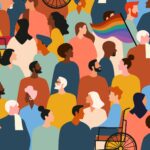How Far Are Dutch Universities Going with Inclusivity?
In 2019, the University of Groningen celebrated its 405th anniversary with an all-inclusive theme to celebrate inclusiveness and diversity at the university. Not long after the theme was announced, a storm of criticism started hovering above the festivities, which in all honesty was more interesting than the festivities themselves, let alone the hugely undersold gala that turned out to be a major flop. From the start, the theme sparked many debates about the meaning of inclusiveness for the university, not to mention the fact that any criticism or remarks about the topic were handled rather poorly. For example, after the celebrations were over, the predominantly Dutch team working on the program complained that little to no budget had been made available to hire diverse queer speakers and artists – instead, the university blew most of its budget on hiring mainstream artists, such as the popular gay singer Gerard Joling. The proposal to use neutral pronouns for gender-neutral artists was even met with hostility from the beginning, as certain team members complained that this was guided towards ‘regulating everyone’s language’. When non-Dutch students complained about the lack of diversity on the banners advertising the festivities, which contained mainly images of white and Dutch-looking students, the university decided to shun the written ‘apology’ from the organisation, fearing that this would only lead to more complaints and controversy. Last but not least, the Diversity Office of the RUG was not even consulted or involved in the organisation, primarily because there was little to no policy to promote anyway. To say that the university was figuratively ‘walking on eggshells’ is rather an understatement. Instead, it was walking on a minefield while some of the mines exploded. Though, rather than giving up, the university walked on maimed and dismembered like the black knight from Monty Python’s Holy Grail, claiming ‘Tis but a scratch’, while others could see that the ‘all inclusive’ theme had ‘decapitated’ the fantasy that the university was a diverse and inclusive one. The more apt theme in all honesty would have been ‘all exclusive’, pointing towards the elements of exclusion instead of diversity and inclusion, as it factually did.
Now, it is easy to bash the University of Groningen for its highly inapt choice for the theme of inclusiveness back in 2019. Plenty of people have already done that. Instead, it would be more worthwhile to ask the question: how diverse and inclusive are Dutch universities nowadays? Of course, diversity and inclusiveness remain highly debated topics, and I want to emphasise that these concepts relate not only to diversity and inclusion of people from different nationalities and ethnicities but also to gender, sexual orientation, and the inclusion of people with disabilities and neurodiverse individuals, among other groups. Since 2020, several organisations involved with research and higher education have made up a plan listing five ambitions, -not goals-, strangely enough. Now, the fact that this plan was launched in 2020 means that diversity and inclusiveness have only really become part of the national agenda rather recently. The main points of the plan include:
- To make diversity and inclusion part of a wider system of education and research.
- To monitor more widely the level of diversity and ensure an inclusive and safe environment for everyone.
- To award universities that are actively promoting diversity and inclusivity.
- To promote cooperation between organisations and universities about diversity and inclusivity.
- To develop a national centre for research into diversity and inclusivity in higher education and research.
However, nowhere in the official publication of the plan – which is only available in Dutch from the Ministry of Education – there is a proper explanation of what is meant by diversity and inclusion. It is mostly explained in very generic and even outdated goals, such as 'hiring more female professors’ – what about queer ones? – ‘combating racism’, ‘paying more attention to people with disabilities and special needs’, and offering an ‘intersectional approach’, which is also not explained any further.
Of course, this national plan remains rather on the surface, allowing universities to come up with their own initiatives. In that regard, it would be interesting to compare different Dutch universities and their approach to diversity and inclusiveness. For the sake of convenience, I decided to select two universities I am, or have been, personally involved with. One of which is the University of Groningen, where I studied for six years and graduated in 2019, not long after the disastrous festivities were over. The second university is my current employer, the VU University Amsterdam where I have been working since 2020 – VU stands for Vrije Universiteit, literally meaning ‘Free University’ in Dutch.
Now the title Vrije Universiteit has a rather dubious history, in which the meaning of the term has shifted significantly. The VU was founded in the middle of the nineteenth century by a group of orthodox Reformed Protestants, led by the charismatic theologian and later prime minister Abraham Kuyper. They decided that the existing universities in the Netherlands had become bulwarks of Enlightenment thought and ‘atheist science’ that would harm the minds and souls of the Reformed Protestant people. In order to promote proper ‘Christian science’ – which they never managed to define in exact terms – the VU slowly gained a foothold during the late nineteenth and early twentieth century. After World War II, however, the Reformed Christian identity of the VU was slowly dismantled as the Netherlands started to ‘de-Christianize’. During the 1960s and 70s, Students at the VU became known as true radicals, as the university newspaper Ad Valvas became a mouthpiece of sexual liberation – it was the 1960s after all –, communist manifestos, and, to the dismay of the few remaining Christians, openly blasphemous writings. Over the years, the VU has reinvented itself as a progressive university with a great emphasis on diversity and inclusiveness. Little reminds us of the university’s original founder, apart from the statue of Kuyper in front of the oratorio. However, the VU has also twisted Kuyper’s legacy as a renowned world traveler and admirer of different cultures – though from a typical nineteenth-century Eurocentric mindset – as a means to reinvent its identity while using old inspiration.
My experiences working at the VU have made me aware of their diversity and inclusion policy, which is emphasised almost everywhere you go. It was, in fact, emphasised in the application for my job that the VU is an open university that promotes inclusiveness in terms of ethnicity, religion, and sexual orientation, but also by allowing equal opportunities for staff members with disabilities – how nice of them... I was also made aware of the existence of VUPride and WO&Men VU, two initiatives from the university’s Diversity Office that organise activities and lectures on topics regarding LGBTQ+-related topics and gender inclusivity. On a normal working day, I see a lot of diversity in nationalities in the student and staff population roaming the campus, although the history department where I work still relies on an 80% Dutch staff, which over the last few years has been slowly complemented by more international staff members. The increased level of diversity, however, can also be the result of its location, as Amsterdam is an expat city by definition and perhaps the most well-known, if not the only known Dutch city worldwide. Nevertheless, the VU was the first Dutch university to appoint a non-European as Rector Magnificus in the form of Indian physicist Vinod Subramaniam – who has now been replaced, sadly enough, by just another white Dutchman. This makes you think that diversity and inclusiveness are rather relative, and after appointing a non-European the university has ranked up enough ‘diversity credits’ to be a bit less diverse in their choice of rector for the coming years.
As you can read through my slightly cynical tone, the level of diversity and inclusiveness remains relative, and I am by no means functioning as the VU’s PR machine. When I was teaching my second-year BA course on climate history, I had a very diverse classroom where Dutch students, for once, were a minority. This, however, was mainly the result of my choice to tick the box ‘open the course for non-history/exchange students’ when designing the course in the university’s system. For me, this was an easy choice, because I greatly believed that my course would benefit from an international and diverse classroom, which it did! Not only did I enjoy the varying input from the students on the topic of climate change, depending on the continent they were from, but I also got to learn more about the benefit of a diverse classroom, not only in terms of nationalities but also in teaching students with different educational backgrounds. For me, it was thus a win-win. However, if I had not ticked the ‘open the course for non-history/exchange students’, I would have been stuck with a decisively less diverse group of students. Don’t get me wrong though, I do not have anything against teaching a homogenous group of Dutch students, which I have also done with great pleasure in the past, but in my specific field of climate history, I would advise against it. In my opinion, certain courses should be taught in diverse classrooms simply because it allows for a more meaningful exchange of knowledge and experiences between the teacher and students. This, I learned, is also part of the VU’s plan for inclusive education. Yet, it made me wonder, why was I then given the choice to ‘open course for non-Dutch/exchange students’, instead of having this as a default option? Of course, this would come with the many side issues concerning language – see my previous blog post – as one language, most likely English, would have to be implemented for this to be realised. As certain studies, like history, are taught as bilingual tracks, offering both a Dutch and international English-taught track, one could also wonder how this would fit within the inclusive education scheme that the university devised. I am not saying that you cannot teach an inclusive or diverse course in Dutch – as there are, of course, many ways to invoke diversity and inclusiveness – but it would score significantly lower.
Back to Groningen. Here, there have also been some initiatives to promote diversity and inclusiveness since the ‘inclusiveness disaster’ of 2019. This, of course, focuses on all the aspects that are also part of the national plan that I mentioned before. The only ‘unique’ aspect I could find was the Centre for Gender Studies (CGS), which is part of the Faculty of Arts and focuses on ‘connecting gender specialists within the University of Groningen as well as institutions and groups outside the university’. Perhaps this was also meant as an upright apology for the blatant refusal to spend the budget on queer speakers during the 2019 celebrations, which should, of course, never happen again. But gender is only one specific aspect of diversity and inclusiveness. One popular complaint that was voiced during the 2019 ‘inclusiveness disaster’ was the general ‘whiteness’ of the university, especially its staff, and the city of Groningen in general. Of course, Groningen is not the international hub that Amsterdam is, but that does not mean that, for example, more work can be made on diversifying the staff population – although that goes for all Dutch universities if you look at the numbers. One could also wonder if the accessibility for disabled or gender-neutral persons has increased ever since, which was scrutinized heavily in 2019, and is also not achieved by making a few toilets appear ‘gender-neutral’ – see the blog post on ‘Heteronormativity on University Campus, 20 June 2022’.
I could go on and write more subsequent blog posts about this topic as we go, but the most important message to all universities in the Netherlands should be: think proactively about what you mean by diversity and inclusiveness! When you want to measure diversity and inclusion, add specific definitions and measurements, otherwise, any effort can easily be lost in vanity. It is easy to put in leaflets that you are diverse and inclusive as an institution, but if your staff and student population are far from diverse and the university far from inclusive to most people, you should really go back to the drawing board. Make sure that the policymakers and executioners are representatives of the groups they intend to represent. The national policy plan from 2020 has pointed out a few important points to which universities should adhere, but this is a rather minimal starting point. Plus, how does this work out in practice? How does it show in the workspace and in the classrooms? When I ended my course on climate history, a student came to me and told me that it was very appreciated that I asked for each student’s pronouns at the start of the course, which was usually not the case apparently. Still, more importantly, what is going to happen after this plan is supposed to be ‘realised’ in 2025? Are we going to say ‘well, we have achieved all the points listed, let's close the book now’? And who calls the shots on whether it truly has been realised? The same people who thrived on pre-diverse and inclusive policies? Or are we going to keep the discussion on diversity and inclusiveness alive and kicking? We should, above all, avoid the ‘inclusiveness disaster’ that hit Groningen in 2019 as the prime example of a premature celebration of an inclusive university that simply did not exist, and perhaps is still far from a reality. Diversity and inclusiveness are relative terms that develop over time and should be re-evaluated and re-drawn regularly, and we should avoid ‘celebrating diversity and inclusiveness’ at any point, as this is no reason for celebration. You can celebrate a birthday or the winning of a prestigious prize, but diversity and inclusiveness should be part of any university’s policy to provide a safe and meaningful environment for research and education, and not a brief ‘hurray'.
About the Author
Author: Dániel Moerman (he/him) was born in the Netherlands to a Hungarian mother and a Dutch father. He was raised bilingually and considers Dutch and Hungarian as his native languages. He studied history and philosophy in Groningen, with an interest in the history of science and universities, and currently works at the VU University of Amsterdam as a Ph.D. candidate in a project on the history of drought as a climatic hazard. Aside from writing about environmental and climate topics, he is also interested in issues regarding higher education and diversity.
Editor & Co-editor: Francis Urciullo & Alexandra Alexandrova



